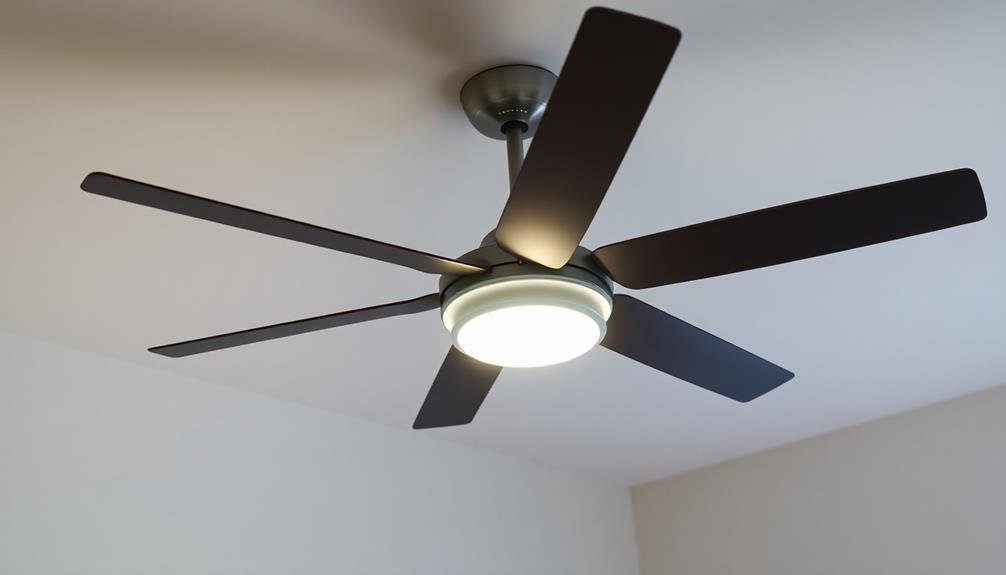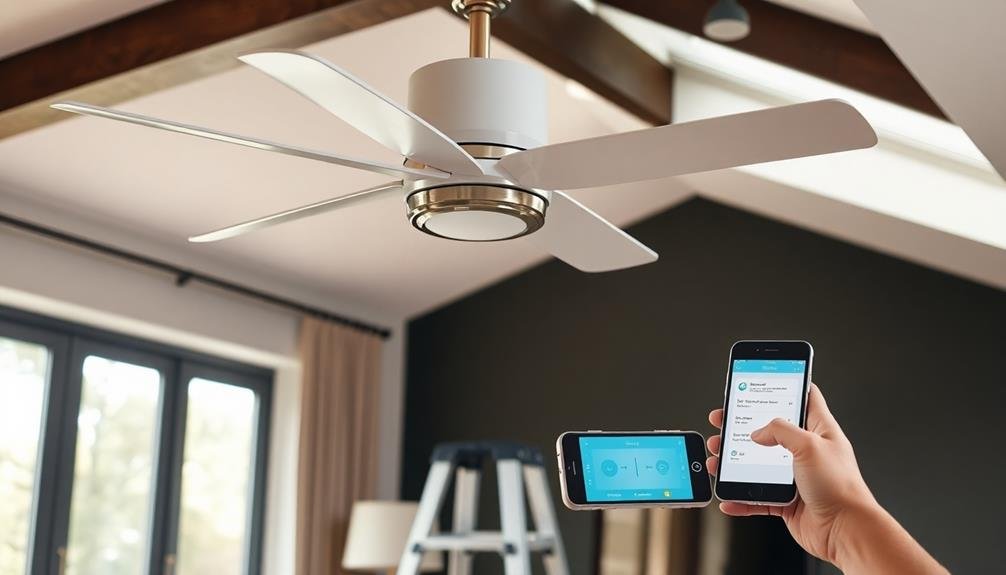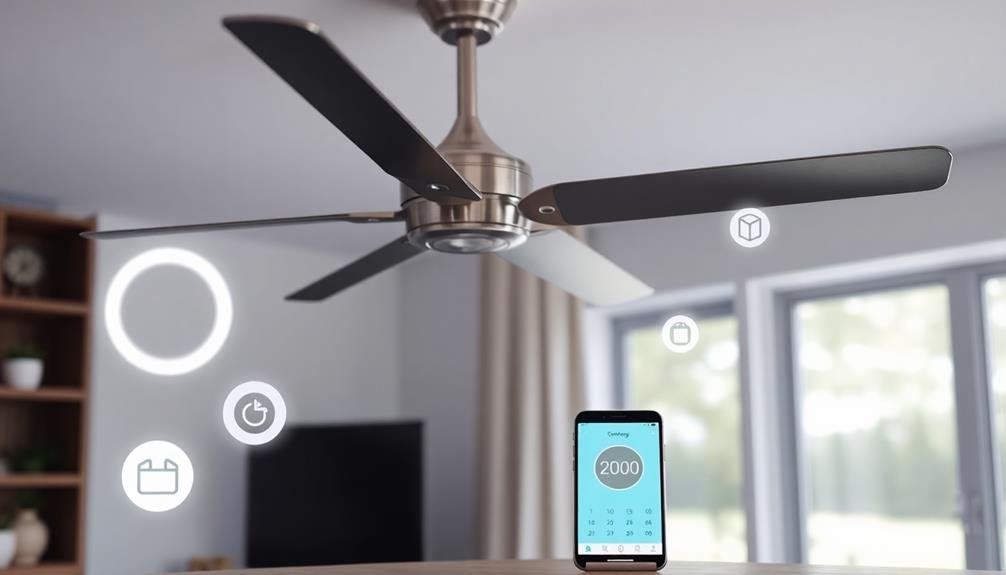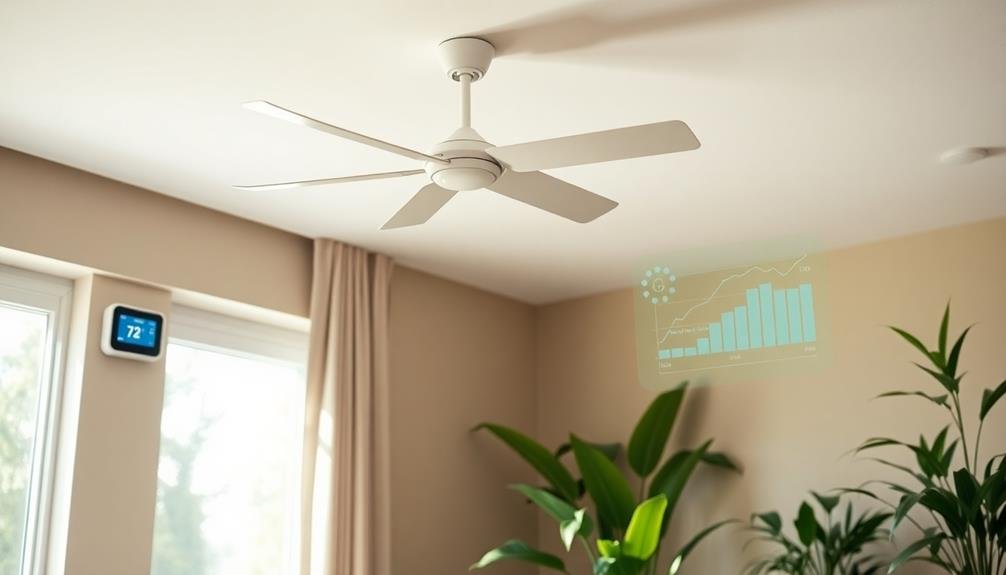Looking for the best automated ceiling fans to save energy? You'll want to take into account the Haiku L Series with its SenseMe technology, the Hunter Symphony featuring a WhisperWind motor, and the Modern Forms Aviator with its energy-efficient DC motor. For a budget-friendly option, try the Honeywell Carnegie LED, or go for style with the Minka-Aire Light Wave. These smart fans offer features like occupancy sensors, temperature detection, and integration with smart home systems. They can reduce your cooling costs by 10-15% in summer and even help with heating in winter. Discover how these innovative fans can revolutionize your home's comfort and efficiency.
Smart Ceiling Fan Features

How do smart ceiling fans differ from their traditional counterparts?
Smart ceiling fans come equipped with advanced features that make them more efficient and user-friendly. They often include built-in sensors that detect room occupancy, temperature, and humidity levels. These sensors allow the fan to automatically adjust its speed and direction for peak comfort and energy savings.
You'll find that many smart fans can be controlled via smartphone apps or voice assistants like Alexa or Google Home. This means you can easily adjust settings, create schedules, or turn the fan on/off remotely.
Some models even integrate with your home's smart thermostat, working in tandem to maintain prime room conditions.
Another key feature is the ability to reverse blade direction seasonally. In winter, the fan can rotate clockwise to push warm air down, while in summer, it can spin counterclockwise to create a cooling effect.
Many smart fans also come with LED lights that can be dimmed or color-adjusted to suit your preferences. Some advanced models even have air purification systems or humidity control features built-in, further enhancing your home's comfort and air quality.
Top Energy-Efficient Automated Models
With the advanced features of smart ceiling fans in mind, let's explore some of the top energy-efficient automated models available today.
The Haiku L Series by Big Ass Fans leads the pack with its sleek design and SenseMe technology, which automatically adjusts fan speed based on room occupancy and temperature. It's WiFi-enabled and integrates seamlessly with smart home systems.
Hunter's Symphony ceiling fan offers impressive energy efficiency with its WhisperWind motor and reversible blades for year-round comfort. It's compatible with Amazon Alexa and Google Home for voice control.
The Modern Forms Aviator smart fan boasts a DC motor that uses 70% less energy than traditional AC motors. It features built-in LED lighting and can be controlled via smartphone app.
For budget-conscious consumers, the Honeywell Carnegie LED ceiling fan provides energy-efficient operation with its remote control and reversible motor.
The Minka-Aire Light Wave smart fan combines style with functionality, offering a dimmable LED light and compatibility with various smart home platforms.
These models showcase the best in automated ceiling fan technology, helping you save energy while maintaining ideal comfort in your home.
Installation and Setup Guide

Installing and setting up an automated ceiling fan might seem intimidating, but it's a straightforward process with the right guidance.
Begin by turning off the power to the existing fixture at your home's circuit breaker. Remove the old fan or light fixture, and install the mounting bracket that comes with your new automated fan. Attach the fan's downrod and canopy, then hang the fan motor on the mounting bracket.
Connect the wires according to the manufacturer's instructions, typically matching colors (black to black, white to white, and green to ground). Secure the canopy to the ceiling, then attach the fan blades. If your model includes a light kit, install it now.
Once the physical installation is complete, it's time to set up the automation features. Download the manufacturer's app on your smartphone and follow the prompts to connect your fan to your home's Wi-Fi network.
You'll be able to create schedules, set temperature thresholds for automatic operation, and integrate with smart home systems like Amazon Alexa or Google Home.
Cost-Benefit Analysis
When considering an automated ceiling fan, it's crucial to weigh the costs against the potential benefits. The initial investment for these smart devices typically ranges from $200 to $600, depending on the brand and features.
However, you'll need to factor in potential energy savings over time. On average, automated ceiling fans can reduce your cooling costs by 10-15% during summer months. They achieve this by automatically adjusting speeds based on room temperature and occupancy, ensuring ideal air circulation without wasting energy.
In winter, they can help distribute warm air more efficiently, potentially lowering heating costs by 5-10%. To calculate your potential savings, consider your current energy bills and climate. If you live in a hot region with high cooling costs, you'll likely see a faster return on investment.
Most users report breaking even within 2-3 years, after which the fan continues to provide savings.
Don't forget to account for increased comfort and convenience. The ability to control your fan remotely or set schedules can greatly improve your living experience, adding value beyond mere energy savings.
Integration With Smart Home Systems

The integration of automated ceiling fans with smart home systems elevates their functionality and convenience. You'll be able to control your fan through voice commands or smartphone apps, making adjustments effortless. Many smart fans are compatible with popular platforms like Amazon Alexa, Google Home, and Apple HomeKit.
By connecting your automated ceiling fan to your smart home ecosystem, you can create custom schedules and routines. For example, you might set your fan to turn on automatically when the temperature rises above a certain threshold or coordinate its operation with your HVAC system for ideal energy efficiency.
Here's a comparison of smart home integration features for different automated ceiling fan brands:
| Brand | Voice Control | App Control | IFTTT Support |
|---|---|---|---|
| Hunter | Yes | Yes | Yes |
| Big Ass | Yes | Yes | No |
| Haiku | Yes | Yes | Yes |
When choosing an automated ceiling fan for your smart home, consider factors like compatibility with your existing devices, the range of available features, and the user-friendliness of the associated app. Some advanced models even offer occupancy sensors and learning capabilities, further enhancing their integration with your smart home setup.
Frequently Asked Questions
How Noisy Are Automated Ceiling Fans Compared to Traditional Models?
You'll find automated ceiling fans are generally as quiet as traditional models. They often use advanced motors and improved blade designs, which can actually reduce noise. Some even have specific "quiet" modes for minimal sound during operation.
Can Automated Ceiling Fans Be Used Outdoors or in Humid Environments?
You can use automated ceiling fans outdoors or in humid areas, but you'll need to choose models specifically designed for these environments. They're usually rated for damp or wet locations and have weatherproof components to withstand moisture and temperature fluctuations.
Do Automated Ceiling Fans Require Regular Maintenance or Cleaning?
You'll need to maintain your automated ceiling fan regularly. Clean the blades monthly to prevent dust buildup. Check for loose screws or wobbling every few months. Replace batteries in remote controls annually. Lubricate moving parts as needed.
Are There Child-Safety Features Available for Automated Ceiling Fans?
Yes, you'll find child-safety features on many automated ceiling fans. They often include remote controls, wall-mounted switches, and safety clutches. Some models also offer blade guards and lower hanging heights to prevent accidents with curious children.
Can Automated Ceiling Fans Be Controlled Manually if the Smart System Fails?
You'll be glad to know that most automated ceiling fans can be controlled manually if the smart system fails. You'll typically find a wall switch or pull chain that allows you to operate the fan without relying on automation.
In Summary
You've now got the lowdown on the best automated ceiling fans for energy savings. With smart features, top-rated models, and easy installation, you're all set to make an informed choice. Remember to weigh the costs against long-term savings, and consider how these fans can integrate with your existing smart home setup. By choosing the right automated fan, you'll enjoy comfort, convenience, and reduced energy bills for years to come.





Leave a Reply